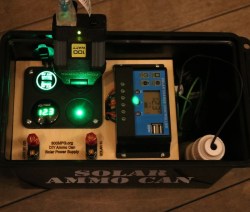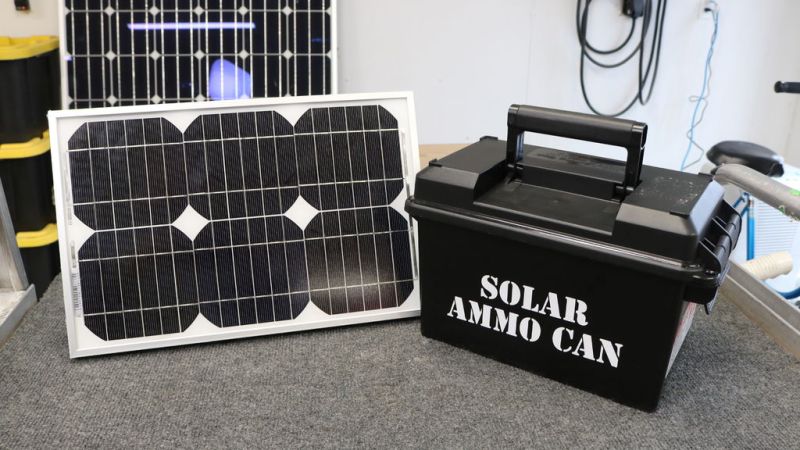When spending time camping, people often bring lanterns, flashlights, and the like — you might even bring along a solar charger. Instructables user [bennelson] is combining all your electrical powered needs by cramming solar power into a can.
Already designed to resist the elements, [bennelson] is using a 50cal. ammo can for a portable enclosure. Inside, he’s siliconed a 15AH, 12V lead-acid battery in the centre to maintain balance and to leave room for the wiring and storage. One cardboard mockup later, he laser-cut the top panel from  1/8″ plywood and secured a 20A solar charge controller, a four-in-one socket panel, and two banana plugs on its top face.
1/8″ plywood and secured a 20A solar charge controller, a four-in-one socket panel, and two banana plugs on its top face.
[bennelson] is using 12 AWG wire to match the 20A rating of the solar charge controller — including a fuse for safety — and lever lock-nut connectors to resolve some wiring complications. Industrial velcro keeps the top panel in place and easily removed should the need arise. When he’s out camping, he uses an 18V, 1A solar panel to charge, but can still use a DC power adapter to charge from the grid. Check out the full build video after the break!
[bennelson] has stuffed a few conveniences into the ammo box — a goose-neck LED light, an LED bulb and long cord to hang up over a tree branch, and a 100W AC Power inverter for any larger appliances at home or on his patio.
Be it camping, tailgating, or festivals, solar powered batteries are a handy piece of kit for any occasion.















That looks like a very nice, complete build including the often forgotten fuse. Very good job.
Mmm – weight well be an issue for camping use. Use a light weight & reliable LiFePO4 battery instead? Unlike Li-ion they’re much more tolerant of abuse too. They’re still more costly of course, but increasingly being found in “Jump starts” & the likes of sports motorcycles.
I thought about a project like this with Lithium batteries, however it is weirdly hard to find reputable sources that have battery protection built in.
You can buy the protection boards separately from other equally unfamiliar places, but by that time it just ended up being cheaper to buy those ‘solar generators’ off of Amazon. Not very hacker-y, I know, but I guess I’ve seen enough horror stories from the quadcopter guys to be little nervous around home-made solution. Particularly something that would ideally be able to be unattended both in charge and discharge.
That’s very neat build.
Though I’ve found with those style of eBay solar ”regulators” some of them are not very good at regulating – ie very slow response in particular.
It’s good to see that the sytem is reverse voltage tolerant as well :-)
When building these types of power supplies I would suggest following the ARES/RACES ham radio power standard.
Using the 15/30A Anderson power pole connectors, in the proper way, you can share charge, radio, and other battery/load sources with a known connector specification. The Victor Amateur Radio Club’s W2VTM has a nice summary article, with purchase options at the bottom.
Please take a look.
http://www.qsl.net/w2vtm/powerpole.html
I would double up on battery capacity (possibly with LiFePO4) and make it possible to bypass the charge controller (both for RFI issues, and redundance if it breaks down, just keep en eye on the voltmeter)-
I would also double up on panels 2X20W frameless on glassfibre is about the same weight.
And finally, I would skip the fancy USB outlets and the inverter and just use my car charger in the lighter socket, but only plugged in when in use.
I have a smaller setup now, but if I would start over I would go for capacity
A lotta HackaDay, I can appreciate, and some I hope to copy bits of later, but much leaves this old R&D war dog in the dust. But stuff like this I love and understand. Power is backup. New small generators will sync w a control-sync cable. Have 2, 2Kw generators? Good. Need a 4Kw? Merge the 2. His concept is expandable… scaleable. Only the invertors do not sync up. And I like his basic size and low $ approach. 15AH battery? You won’t use 1.5A for 10 hours, I hope, but it keeps sentry stuff on alert all night. 2phs and 2 other devices charging back up. I WISH the solar panels folded up and out… to fit maybe in a second can, but I would want 1, backpack mounted.
Soldered V Un-Soldered wire and current…!!!
Something that I have always wondered was when putting wires in to chocolate blocks or connectors etc by soldering the ends rather than sticking them in the hole and screwing them or crimping them are you reducing the current carrying capacity of the wire?
Some time back I had a connector on my 3D printer burn out/melt when i soldered the end of the wire and screwed it in to the connector however unsoldered and screwed down it has never given any issues.
I was looking at this project as I have been thinking about doing something similar for work except with a couple of big deep cycle batteries. On site we do not often have access to power and we use a lot of battery powered tools. I was thinking about making a large charging station and mounting it in the back of the truck. Let it charge while I am driving two and from site then charge the tools on site.
Most of the tools are 18V so maybe either using a buckboost converter for the charger to charge the 18V lipo’s or put two batteries in for a 24V system.
Soldered cables under a screw terminal are a no-no. They reduce the contact area to a point (because the cable can no longer distort around the terminal screw). The smaller contact point gives a higher resistance joint. This leads to temperature rise at the joint. This can exceed the low meling point of solder. Once this happens the strands are no longer held in place which can lead to an even worse connection, then higher resistancce, even higher temperature and even critical failure ( which you experinced). There is a reason electrical standards forbid soldered cables being screw clamped.
Agreed, it’s a bad idea. The solder is solid but very malleable so no significant tension can be built up in the clamping action on the screw. Without the tension the screw is always effectively loose and gives a poor connection.
Is that the same in crimp connectors? I often used to solder them so they were a little more stable rather than just crimp them. Just goes to show… I have been doing it all wrong all these years and you are never too old to learn new tricks.
:)
Thanks to you also @Bootstrap
A correctly crimped connection forms a strong cold weld. Can’t find the AMPS or TE vid I saw earlier, but did find a HaD on that topic:
https://hackaday.com/2017/02/09/good-in-a-pinch-the-physics-of-crimped-connections/
Not exactly the same with a screw terminal, but I’d imagine similar.
More like solar power next to a can. I was expecting the PV panel to fold and stow inside the can.
It´s very likely the ammo can was the trigger that made the author write this article. That the solar panel is not in the can is a detail. The important thing is that it´s an AMMO can, otherwise, James likely would not have picked this build.
Thanks for sharing this – we are about to embark on an around Australia trip
That’s a very nicely done piece of kit.
Everything is centered on “1 Amp”. The battery can accept/deliver much more current than 1A, and the wiring (with fuse) is easily capable of >5A. There aren’t any details regarding the solar charger (all such links point to a battery), but this may be the limiting device.
If the solar charger had an internal DC-DC converter, it could accept DC or solar power at 1A/30V (30W)(for example), and convert it all to battery voltage for faster charging (30W/13.8V = 2.2A), and still terminate the charge when needed.
This is great! I have a built a few less polished (redneck) versions of these. I found that solar panels meant for wild game feeders fit perfectly inside the can and are available at tractor supply or amazon. I usually get two of them. They have a diode/charge controller built in and are weatherproof. The sealed lead acid battery is pretty foolproof. I also just put a pair of 12 volt marine barrel plugs meant for boats into the side of the container. These come packaged with a fuse. The whole thing is waterproof and I use it on multi day rafting trips.